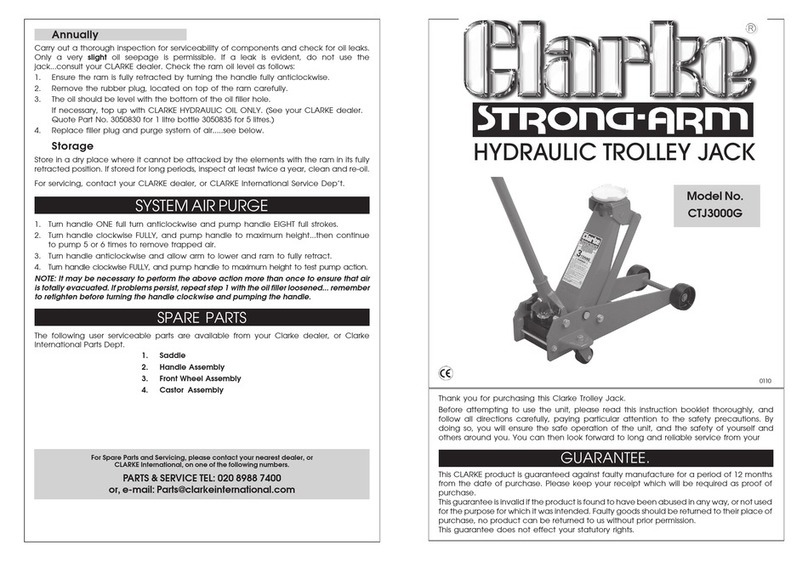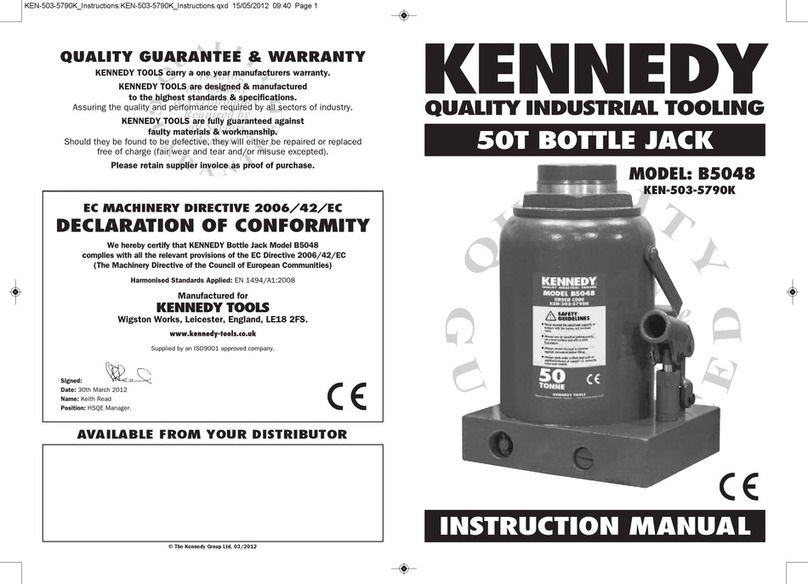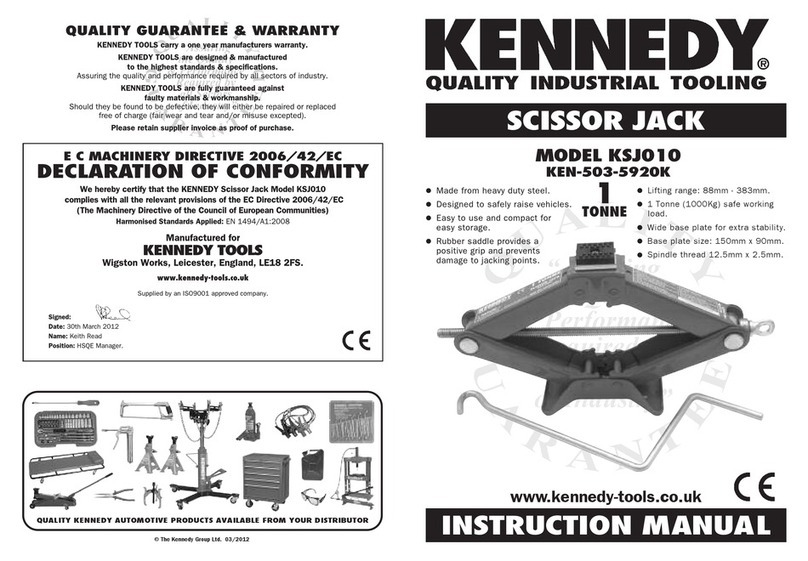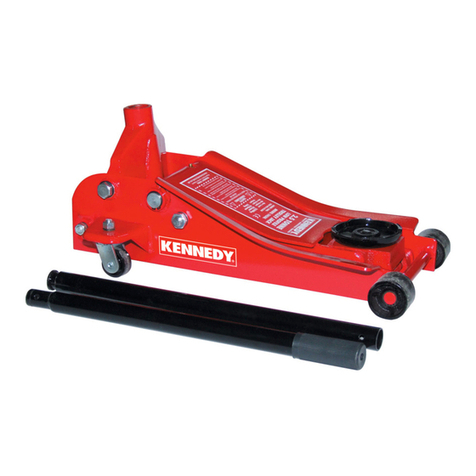
4 5
OPERATING
Before using the trolley jack for the first time, bleed the hydraulic system to remove any air.
Please see page 6 for bleeding instructions.
1. Turn the release valve clockwise until it can no longer be turned (See fig. 3).
2. Lower the handle to a convenient angle by pulling the control rod up (See fig. 4). Ensure the control rod is
locked into position in one of the three holes.
3. Pump the foot pedal to move the saddle to just under the correct height (See fig 5).
4. Use the toe plate to help position the trolley jack underneath the
vehicle (See fig. 6).
5. To help with positioning, the handle can also be locked in three
positions (See fig.7)
6. Pump the handle to raise the saddle into the correct position. Please
refer to the “Car owner’s manual” for the correct jacking points.
7. Check positioning under a slight load to make sure the jack will not slip
when in use (See fig 8). Continue to lift the load.
8. nce the load has been raised to the required height, use an additional
support (i.e. correctly rated stands) before continuing work (See fig 9).
9. To lower the vehicle, remove the additional supports. Turn the handle
anti-clockwise. The speed at which the vehicle is lowered can be
controlled easily by how much and how quickly the release valve is
turned.
TOOLS EEDED: Either two 17mm
sockets or two 17mm spanners.
1. Remove and dispose of the
metal rod which is holding the
handle socket down (See fig. 1).
2. Position the handle over the
spring. Push it down whilst
ensuring that the control rod is
located in the top securing hole
(See fig. 2). Tighten the handle
bolt securely and test to make
sure the handle will not pull out.
A EMBLY
fig. 2
fig. 1
fig. 3
fig. 5 fig. 6
fig. 9
fig. 7 fig. 8
fig. 4
TROUBLE HOOTING
PO IBLE CAU E
1. Low oil level.
2. Air has entered the hydraulics.
3. Ram seal leaking.
1. The release valve has not been fully
closed.
2. The oil level is low.
1. The release valve has not been fully
closed.
2. The oil level is low.
3. The hydraulic system has become
blocked by dirt particles.
1. The hydraulic system has become
blocked by dirt particles.
1. The hydraulic system has become
blocked by dirt particles.
1. Worn or damaged seals.
1. Low oil level.
2. Air in the system.
OLUTION
1. Fill to correct oil level.
2. Bleed the hydraulic system.
3. Replace worn seals
1. Turn the release valve clockwise until
it can no longer be turned.
2. See refilling instructions.
1. Turn the release valve clockwise
until it can no longer be turned.
2. See refilling instructions.
3. Turn the release valve anti-clockwise
and push the piston down quickly.
1. Turn the release valve anti-clockwise
and push the piston down quickly.
1. Turn the release valve anti-clockwise
and push the piston down quickly.
1. Replace worn seals. Look for
excessive contamination or wear.
Replace contaminated oil.
1. Fill to correct oil level.
2. Follow instructions to bleed air from
the system.
FAULT
Unit fails to extend or
extends partially.
The jack will not lift the
rated load.
The jack lowers under
load.
The hydraulic system
will not lower.
The handle raises or
springs back under load
Ram leaks hydraulic oil.
Incomplete or spongy
cylinder response when
foot pedal is pumped.
Repairs must be performed in a dirt-free environment by a qualified person who is familiar with this type
of equipment.
CARE & MAINTENANCE
Periodically check the operation of the jack. Ensure all nuts are fully
tightened and all other fixings are in position and secure. Do not use the
trolley jack if you suspect a fault but refer to the fault finder section below.
To gain access to the hydraulic pump, remove the cover plate using a flat
headed screwdriver (See fig 10).
CHECKING & FILLING THE OIL RE ERVOIR:
1. Place the jack on level ground
2. Always follow the precautions advised by the oil manufacturer.
3. Lower the jack to the lowest position.
4. Remove the rubber filler plug from the cylinder housing. Using hydraulic
oil ISO VG.22.32, fill until the inner cylinder is covered. D N T USE
BRAKE FLUID.
5. Pump the trolley jack unloaded 5 or 6 times to expel air.
6. Add more oil if necessary.
7. Refit the filler plug.
BLEEDING THE Y TEM:
1. Turn the release valve anti-clockwise no more than one complete turn.
2. Remove the rubber oil stopper from the cylinder housing.
3. Pump the handle several times to force out any air.
4. Turn the release valve clockwise until it can no longer be turned.
5. Replace the rubber stopper.
LUBRICATING:
Lubricate the points as indicated in fig.11.
a. HA DLE. Use light oil on moving parts.
b. REAR WHEELS. Use light oil on axles and castor bearings.
c. LIFTI G ARM. Inject grease into grease fitting.
d. SADDLE & LI KAGE. Use light oil on all moving and pivoting parts.
e. HA DLE SOCKET PIVOT BOLTS. Use light oil to lubricate pivot bolts.
f. FOOT PEDAL. Use light oil on moving parts.
g. FRO T WHEELS. Inject grease into grease fitting.
WHEN NOT IN U E:
Wipe clean with a slightly oiled cloth. Store with the release valve open.
a
e
d
c
b
g
f
fig. 10
fig. 11

























